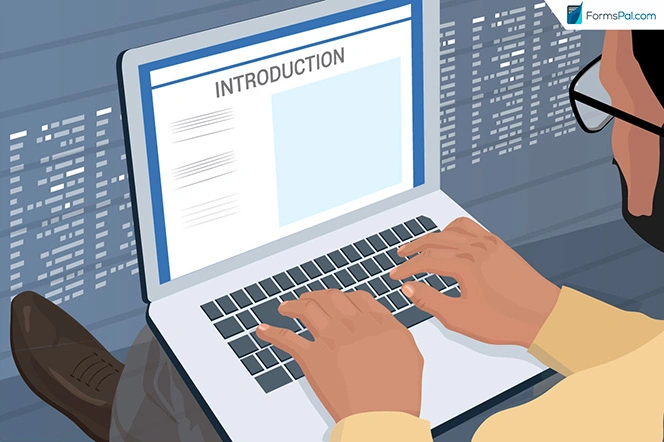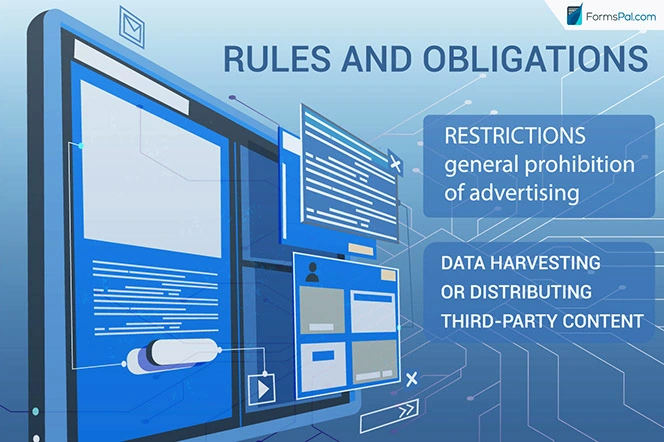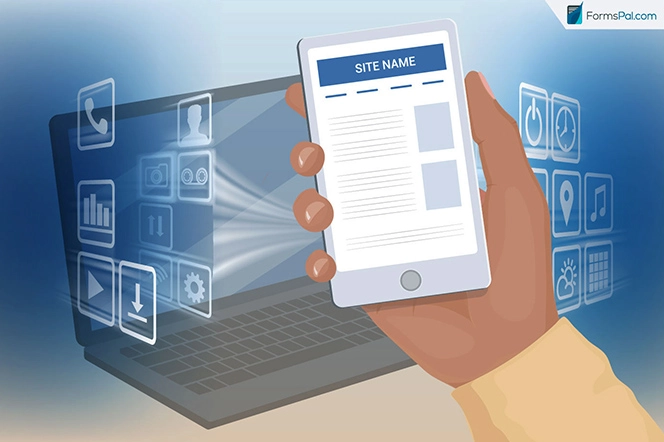Terms and Conditions Template
A terms and conditions agreement allows the company working online to regulate the customers’ activity on the website or in the app. The users must accept the company’s terms and conditions to use its online services. Other names for the agreement are terms of use, terms of service, and a user agreement.
A business entity is not required by law to provide terms and conditions for their customers. However, with a user agreement, you can control your website or application usage and take action against customers who break the rules. Our generic terms and conditions template will help you create a comprehensive agreement for your business’s safe functioning. You can also benefit from our step-by-step guidelines to make the terms for your website clear and understandable.
Build Your Document
Answer a few simple questions to make your document in minutes
Save and Print
Save progress and finish on any device, download and print anytime
Sign and Use
Your valid, lawyer-approved document is ready
What Are the Benefits of Having Terms and Conditions
Terms and conditions ensure that your company will have long-term success. If you still in doubt, whether you need to create terms of use or not, you should consider the following reasons to prepare the agreement:
- It allows you to outline the rules and restrictions your customers must consent to before using the website or mobile app.
- It protects your confidentiality and intellectual property rights (IPR), including logo, visual media, and overall website material.
- In case of unauthorized usage of your data or breach of rules, the users can be held liable under the indicated jurisdiction of the country.
- You can define the consequences of not following your guidelines and freely block or suspend the violators.
- You can limit your liabilities, for example for mistakes or third-party content.
How to Prepare a Terms and Conditions Agreement
With the terms and conditions, you protect your company and inform users about the rules they must follow. Once the users agree to be bound by your terms, you conclude a legally binding contract. In case of any legal dispute, the court will always consider your website’s terms and conditions. That’s why you should be very careful when preparing them. Try to make the document as easy-to-understand as possible, following the next steps:
Step 1. Define the purpose of the agreement

In different situations, you can use different types of user agreements. The terms of service (ToS) are more general and describe overall regulations. If you sell products, it’s better to use an end-user license agreement (EULA). This agreement gives your buyers the license to use a copy of your software. If you do not want to give your users the right to copy your product, you may use a service level agreement (SLA). It defines the level of service your customers can expect from the company, including quality and scope, as well as liabilities if the mentioned quality level is not achieved.
Step 2. Make an introduction

Website standard terms always include the introduction stating that a person accepts all terms and conditions by using the app or website. If users disagree with the terms, they should not be authorized to access the services. Here, you can also include the confidentiality statement and whether minors are permitted to use your website or not.
Step 3. Identify the IPR

It’s necessary to indicate that your website materials are protected by copyright and other relevant laws of the country. Users are granted a limited license to view the materials on the platform or mobile app. In the case of copyright infringement, you can take legal actions against the violators. You should also indicate that your company, in its turn, does not intend to claim any ownership rights to the users’ data.
Step 4. Provide the rules and obligations

The next section of your document should be devoted to the regulations of using the website or app. Here, you should describe the restrictions, including the general prohibition of advertising (if your platform is not designed for such purposes), data harvesting, or distributing third-party content without appropriate rights to it. You should clearly define the rules to follow and explain the consequences of breaking them. It would be best to warn your users about liabilities if they abuse your services.
Step 5. Describe the content clause

In this section, you should provide the statement that your company gets a non-exclusive license to use, adapt, and distribute in any media all the content users display on your website. The users are permitted to post content that does not infringe any third-party rights. Do not forget to warn your users that your company may remove any content from the website without notice.
Step 6. Indicate the liability limits

It’s crucial to limit your liability, indicating that your company is not responsible for third party content or any mistakes in the website content. You can also include the right to provide any modifications to your website material. Here, it’s possible to indicate the indemnification clause, providing that all customers indemnify your company from and against any liabilities or demands.
Step 7. Explain the possible changes

This section provides the company’s right to change or delete the platform or app’s contents periodically. You should also explain to the users that you are allowed to add correct information and update your website content in case of any mistakes or typos.
What Should the Website Terms and Conditions Cover
Website standard terms and conditions usually include several important clauses and sections. Consult our template and make sure that you describe all the important details, such as:
Intellectual property rights
One of the important things to mention in your agreement is intellectual property rights. You should clearly outline that all content and website material belongs exclusively to your company and is protected by copyright and relevant laws of the United States and other countries.
Restrictions
You should limit what users can do using your mobile app or website. Here, you should list all the prohibited activities on your website and warn users about liabilities for using the website in contravention of the terms. It’s possible to limit user access to certain website material or software.
Limitation of liability
You should add liability limits, providing the right to change the content or delete anything on your website anytime. A company often needs to provide a disclaimer that the website should be used for informational purposes only. Such disclaimers are a must for platforms with medical information that should not be treated as medical advice.
Governing law
It’s important to indicate the applicable law, especially if you have customers from all over the world. In case they file a lawsuit, the disputes will be resolved according to the country’s jurisdiction and laws of the state indicated in the terms and conditions agreement.
Filling out a Terms and Conditions Agreement
Use our website standard terms and conditions template to create the terms specific for your business. You can always look for additional terms generators and pdf-examples to inspire yourself. Please, follow the next steps while working on your website terms and conditions:
Step 1. Identify the company
At the beginning of the document, it’s necessary to identify your company name and what services you provide. It’s also necessary to indicate the link to your website or application. Website standard terms usually include the statement about minors’ access. If it’s relevant, you can inform users about the age from which they can use your service or software.
Step 3. Include the IPR statement
Generally, terms and conditions should include the IPR statement. It’s important to list all the materials protected by copyright and indicate that users have only a limited license to view them. Here, you can also indicate that your company does not intend to claim any ownership rights to the users’ data. Additionally, you should warn the customers not to distribute data from third-party websites without holding appropriate rights.
Step 2. Add necessary clauses
Our website standard terms and conditions template includes general clauses that can be extended according to your specific business needs. Thus, if you sell products, you should add the non-exclusive license clause that allows your buyers to copy and use your software. In this case, you should also warn that any content of the software cannot be modified or reproduced without your consent. Here, you can add links to privacy or refund policies and limit user access to certain materials.
Step 5. State the liability limits
Limitation of liability is one of the important things to state in your document. You should provide the disclaimer that you are not responsible for third party content or for any mistakes in the content. In this section, you can also provide the liabilities for data harvesting, damaging your website, or an overall breach in terms. Do not forget to include indemnification clauses.
Step 3. Identify the termination clause
It’s necessary to inform users about the possibility of terminating the agreement. It is especially relevant for companies offering software as a service (SaaS) applications and selling products.
Step 4. Indicate the governing law
It’s necessary to identify the jurisdiction under which any disputes will be resolved. You should inform users about the applicable law to avoid any future misunderstandings. As a general rule, the governing laws are laws of the state or country where the business entity has its headquarter.
Step 5. Add contact details
At the end of your terms and conditions, you should indicate the user’s contact information if they have any questions. Usually, companies leave an email address. Creating terms and conditions is only half of the battle. You have to ensure that your customers are aware of them. You can enforce your terms and conditions by using either a browsewrap or a clickwrap agreement. The first one usually means that the users implicitly agree with the terms by using the website or mobile app. The notice with the link to terms and conditions is usually placed at the bottom of the website. The second agreement requires action, that is, to click a button, “I agree” or “Accept” to confirm the awareness of the terms. In this case, a user must agree with the terms to access the website or application. The clickwrap agreement is always preferable because it proves that the user has read the terms. With the browsewrap agreement, it’s hard to ensure that your users know the terms. A privacy policy is required for companies collecting and storing the personal data of the customers. The website privacy terms go separately from the terms and conditions agreement and describe how the company collects, stores, and uses personal information. The requirement to have privacy terms became widespread after the European General Data Protection Regulation (GDPR) and the California Online Privacy Protection Act (CalOPPA) were drafted. The CalOPPA protects California residents’ data and indicates that all websites collecting personal information must include understandable privacy terms. Since almost every website and app collects some personal information directly or indirectly, they need to have privacy policies in most cases.
Frequently Asked Questions
How to Make My Terms and Conditions Agreement Enforceable?
When Is a Privacy Policy Required?